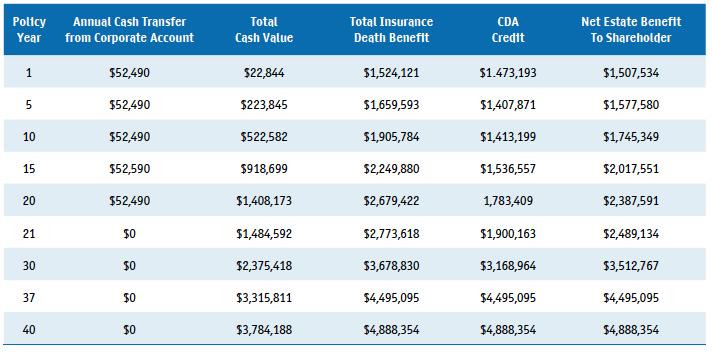A Tax-advantage Investment For Business Owners
 Last month I attended a seminar given by local business professionals about the benefits of incorporating your business. The audience included several proprietors, including doctors and dentists practising in the nearby community. The seminar offered plenty of information on financial planning for business owners and medical professionals, and covered a wide range of tax-reduction strategies.
Last month I attended a seminar given by local business professionals about the benefits of incorporating your business. The audience included several proprietors, including doctors and dentists practising in the nearby community. The seminar offered plenty of information on financial planning for business owners and medical professionals, and covered a wide range of tax-reduction strategies.
The main topics of discussion were the four significant tax advantages of incorporation: the small business deduction; tax deferral by retaining earnings in the professional corporation; income splitting-issuing salary or dividends to family members in lower tax brackets; and the capital gains exemption for qualifying small business shares (if your business or medical practice can be sold).
Although I am quite familiar with the tax advantages of incorporating your business, my interest was looking at ways in which people can reduce corporate tax payable on investments held within a corporation and their relation to the types of income generated from that corporation.
Active Income Versus Passive Income
Active business income is income that is generated by actively doing something. In other words, your business provides some type of goods or service, or is involved in manufacturing or sales. The combined federal/ provincial rate for active income earned by Canadian Controlled Private Corporations (CCPCs) which is less than $500,000 is 15.5% for 2015. This consists of 11.0% federal tax and 4.5% provincial tax (Ontario, for this example).
This can be compared to passive business income which is typically investment income. The combined federal/Ontario passive investment tax rates for corporations for 2015 are 46.17% interest/foreign income, 33.33% dividends and 23.08% capital gains.
Clearly, money held in your corporation as passive investment is taxed at the highest corporate tax rate compared to active income. As a result of an increase in corporate tax rates on investment income, there is no longer any tax deferral and tax savings advantage to earning investment income inside the corporation, as was the case in the past.
Business owners who are shareholders of private corporations and have cash flow in excess of what is required to operate their business will often accumulate wealth within their company as retained earnings. Most prefer not to take extra income or dividends from the company and pay more tax. Their annual income is sufficient enough that doing so does not mean sacrificing their lifestyle. By leaving the money in their company, there can be a significant tax deferral rather than distributing it through dividends or income then paying personal tax on it. However, these retained profits or surplus of cash build passive investment portfolios that typically consist of investment vehicles that return a mix of interest, dividend and capital gains. The high amount of tax paid on passive investments and the loss of wealth due to loss of compounding growth can make this type of investment at times less desirable.
An alternative solution would be to invest the profits into a corporate-owned, tax-exempt permanent insurance policy. An exempt insurance policy is defined in regulations 306 and 307 of the Income Tax Act (ITA). The ITA provides that the cash value accumulation is exempt from annual accrual taxation, provided certain conditions within the regulations are met. Significant cash values can accumulate on a tax-deferred basis if the maximum deposits permitted by the ITA are deposited into the exempt policy. The deposits can be designed so that they remain tax-sheltered within the contract.
Not only does a corporate-owned exempt policy allow for tax-deferred growth of the cash value of the policy, but there’s also a mechanism that allows the death benefit proceeds to go tax-free to shareholders through the corporations capital dividend account (CDA). The CDA credit is unique to corporate-owned life insurance. Upon death of the insured, a private corporation receives the death benefit tax-free and that amount less the adjusted cost basis (ACB) of the policy is added to the corporation’s capital dividend account. The policy’s ACB is generally the sum of the cumulative premiums paid minus the cumulative net cost of pure insurance. The CDA balance resulting from receipt of death benefit proceeds from a life insurance death benefit will remain until such time as capital dividends are elected. This allows corporations the ability to elect to pay a capital dividend when it’s most advantageous for shareholders. Since payment of capital dividend is elective, detailed knowledge of tax legislation is required. I would recommend your accountant be involved in the election process.
Tax-advantaged growth and tax-free distribution on death results in corporate-owned permanent life insurance having two significant and unique tax advantages over traditional investments.
Case Study: Dr. Brown
It’s been ten years since the government of Ontario allowed both doctors and dentists to incorporate their medical practices. The change became effective January 1, 2006 and in December of that year, the legislation was passed into law. These professionals can now have what is known as a medical professional corporation. Once this passed into law, many doctors and dentists chose to incorporate their business, although not all have taken advantage of this legislation.
Dr. Brown is a family physician who has been practising in the province of Ontario for more than fifteen years. He incorporated his medical practice back in 2006. He is a widower with two children, and at the age of 45 has excellent health. During the past ten years, his income and investment earnings ranged from $145,000 to $275,000 per year which includes investment income held in his professional medical corporation.
Dr. Brown is generating a significant amount of excess cash flow each year and retains a considerable portion of business profits within his corporation. He has been able to accumulate well over $750,000 of savings in his corporate account. These funds are currently in traditional investments which include GICs, dividend- paying stocks and bonds, and preferred and common shares. Every year his company pays tax on the income generated from these passive investments.
He is looking for an effective strategy to transfer some of these passive corporate assets from a taxable environment to a tax-advantaged environment. The objective then is to transfer taxable surplus into non- taxable surplus and to reduce capital gains tax on the corporate shares at death.
The solution was to set up a corporate-owned, tax- exempt permanent insurance plan. His corporation would own and pay for the plan and would also be named as beneficiary (otherwise potential taxable shareholder benefits could arise).
Using corporate dollars to pay the insurance premiums was an attractive opportunity. The main advantage is that Dr. Brown can realize significant annual savings by having his corporation own the policy and pay the premiums with retained earnings from his active medical practice. Generally, the corporate tax rate is lower than his personal tax rate, which means it would require less pre-tax income to fund the premiums through the corporation compared with paying for them personally.
Using the example chart below, Dr. Brown purchased a permanent insurance plan with an annual premium of $52,490. His personal marginal tax rate would be 49.53%, while his corporation’s tax rate is closer to 15.5%. If Dr. Brown were to purchase the policy personally, his corporation would have to earn and then pay $104,002 to Dr. Brown in order to have $ 52,490 after tax to pay the annual premium. In contrast if Dr. Brown’s corporation owns and funds the life insurance policy, the corporation would only have to earn $ 62,118 before taxes to fund the $52,490 annual premium. The result is that the corporation saves about $ 41,884 per year when the premiums are paid with corporate dollars and keeps $41,884 more per year in their corporate savings account.
Then every year for a maximum of twenty years, Dr. Brown would simply move $52,490 from his corporate investment account to fund his new tax-exempt insurance plan. This strategy creates an immediate tax-free estate of $1.5 million and builds up a tax-deferred savings plan for Dr. Brown of $1.4 million after twenty years.

Note:The above illustration was provided by a highly- rated Canadian insurer offering permanent tax-exempt insurance consistently releasing dividends to its policy owners for over 125 years. Illustration assumes standard rates based on a 45-year-old male non-smoker. Total cash values include a guaranteed cash value component plus annual dividends. Dividends are not guaranteed and will vary based on a number of economic factors. Total growth on life insurance amounts also depend on dividend distribution and will vary according to economic conditions. Policy cash values can be withdrawn should the need arise and the shareholder will pay tax on any of the accrual gains. The amount of cash withdrawn will reduce the amount of death benefit available to beneficiaries.
Some Points To Consider
If Dr. Brown did nothing and left all of his passive assets in traditional corporate investments, on his death the Canada Revenue Agency (CRA) would consider this a deemed disposition. A corporate dividend would be released to his estate and subject to provincial dividend tax paid on non-eligible dividends. Over one-third of his investment could end up going to CRA. Since Dr. Brown’s intention was to leave most of his corporate assets to his children, a tax-exempt insurance plan became an important part of his overall estate plan.
When owned by a corporation, a tax-exempt life insurance policy may not be protected from creditorsof the corporate policy owner/beneficiary. Typically, a business owner will have their holding company own the policy to protect the policy’s cash value from potential creditors of the operating company.
There are several insurance carriers offering tax-exempt permanent insurance plans, so it is best to shop around for the best cash values and net cost of insurance available.
Rino Racanelli is an independent insurance advisor in Toronto, ON. He can be reached by phone 416-880-8552 and by email racanelli@sympatico.ca. Or you can visit his website www.BackToBackAnnuities.com"
Disclaimer: This article provides information of a general nature only. Always consult a professional lawyer and tax specialist if you have any specific legal questions. This material is for information purposes only and should not be construed as providing legal or tax advice. Reasonable efforts have been made to ensure its accuracy, but errors and omissions are possible. All comments related to taxation are general in nature and are based on current Canadian tax legislation which is subject to change.

